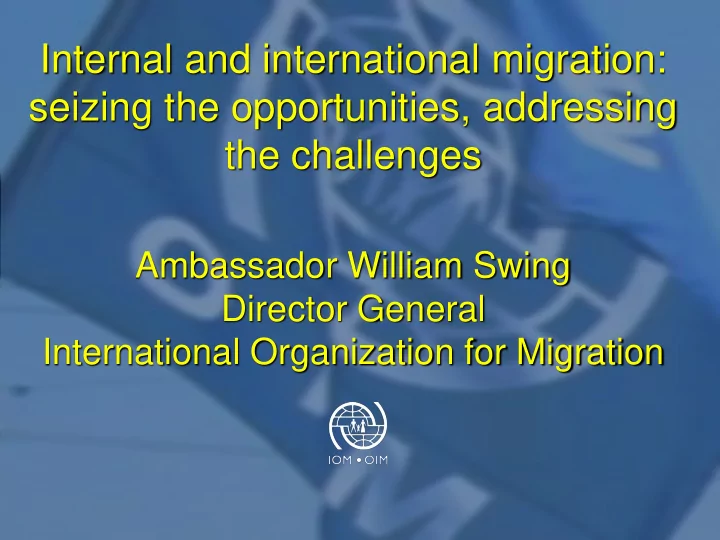

Internal and international migration: seizing the opportunities, addressing the challenges Ambassador William Swing Director General International Organization for Migration
Migration mega-trend: one in seven 7 billion Population 1 billion Migrants 214 million International 740 million Internal Urbanization: 50% + Feminization: ca. 50% 2040: 400+ Million International Migrants International migration will grow even faster than in last 25 years (Intelligence Council on Global Trends 2030, December 2012)
Migration drivers increase complexity DEMOGRAPHY: North – ageing, South – youthful 1. 2. DEMAND labour shortage vs. labour surplus 3. DISPARITY increasing: economic, social 4. DISTANCE shrinking : budget transportation 5. DIGITAL REVOLUTION: instant information 6. DISASTERS: natural & human-made, rapid & slow onset 7. DREAMS: life with dignity and prosperity. Prepare for Increased Mobility
International migrants in context Population: Between 4 th and 5 th Largest Countries 237 million Indonesia 4th 214 million* International Migrants 193 million Brazil 5th Economic Contribution: Size of Large GDPs USD 434 billion Saudi Arabia 23 rd. Annual Migrant Remittances USD 400 billion* 24 th. Austria 28 th. USD 379 billion CAUTION: MIGRANTS NOT COMMODITIES! * Source: World Bank
MDG Agenda • Strengths : – Focus on limited set of concrete, measureable development goals and targets – Commitment & mobilization – Prioritization of resources • Weaknesses: – Gaps among goals, e.g.: peace & security – Lists desired outcomes but with no guidance on how to achieve them
Post 2015 Agenda: Key Issues 1. Growth & employment for growing world population 2. Global risks : vulnerability to shocks, disaster, climate change 3. Financing development in a world of decreasing aid budget
Migration is an enabler of the three pillars of sustainable development Economic development: – Remittances: proven resilience in the face of economic and financial crisis; – Skill shortages: contribution to labour requirements Social development: – Knowledge transfers – Women‟s Empowerment – Health & access to clean water and sanitation Environmental protection: – Climate change and disaster risk reduction – Urbanization and land degradation
It is also linked to peace and security Conflict: – Migration as a result of conflict – The emerging issue of migrants in crisis Human security: – Human smuggling and trafficking undermine human security – Conflict can increase vulnerability to these transnational crimes
Whether or not migration leads to positive or negative outcomes depends on its good governance … The development „ enabler ‟ potential of migration is contingent on: – The overall size or quantity of migration: how many people can move? – The selectivity of migration: who has access to safe, legal and humane migration? – The quality of migration opportunities : are migrants‟ rights being protected, and under what conditions do people migrate? Government policies can make a difference to all these outcomes.
… and its inclusion in the Post -2015 Development Framework Post-2015 objectives should include: 1. Recognition of the contribution of migrants and migration to all three pillars of sustainable development (economic, social and environmental) 2. Renewed commitment to protection of human rights of all migrants 3. Systematic inclusion of migration issues in post-2015 UN development agenda
There are many tangible ways to include migration in post-2015 development analysis and strategies 1. Improve public perceptions of migrants 2. Factor migration into development planning, at national, regional and global levels, including in the post-2015 development agenda 3. Protect the human rights of all migrants 4. Manage migration in crisis situations 5. Enhance the evidence and knowledge base 6. Promote policy coherence and institutional development
But a key hurdle will be to overcome political imperatives Addressing the migration policy dilemma: National Sovereignty Individual Mobility Right to determine who enters Desire for a better life Expects respect for laws & culture Expects human rights Partnership in Practical Solutions Dialogue grounded in sound, evidence-based analyses Transparent & Informed “High Road” Policy
A High Road Migration Scenario Multiple-entry visas 1. Dual citizenship laws 2. De-criminalization of irregular migrants 3. AVRR as rights-based alternative to deportation 4. Process for legal status for those meeting criteria 5. Integration as an option for migrants 6. Portable social security benefits & access to services 7. Migrant access to health services & education 8. Multi-skill policy for all skill levels 9. Circular migration programmes 10.
Recommend
More recommend